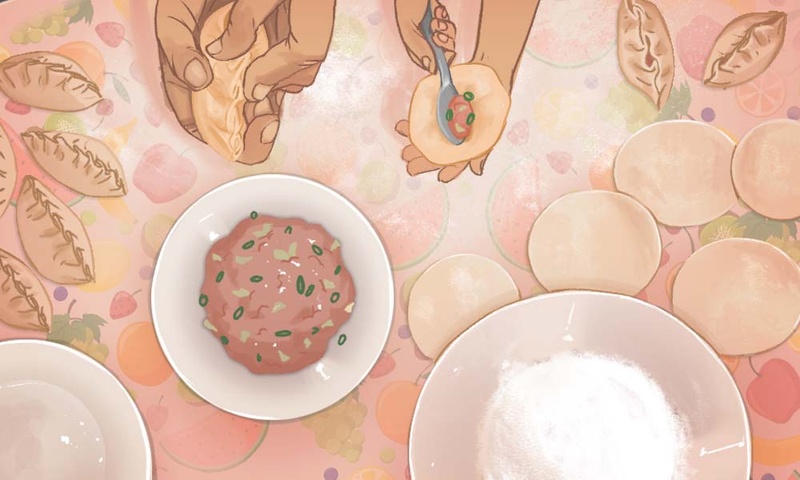I don’t have many vivid memories of my childhood, but I remember that day well. I don’t know how old I was. Baachan had gathered several mothers, including mine, her daughter-in-law, for what today I would call a “gyoza workshop.” Baachan’s gyoza was well known among family and friends, having a guaranteed spot on the table whenever we visited our grandparents in Mogi das Cruzes, an hour away from the city of São Paulo, where I’ve lived since the age of two. It was the best gyoza in the world, for it was the only one I knew and ate, at first leery of the filling, but soon won over by its unique and unmistakable flavor.
On that particular day, the women wore aprons while assembled around the spacious four-seater kitchen table to learn how to prepare the meat filling; Baachan mixed ground beef and pork in the same proportions, along with chard or cabbage, a few garlic chives, and various seasonings: salt, garlic, ginger, sesame oil, soy sauce, etc. They were also about to learn how to place the stuffing in the dough before closing it by making those little folds so characteristic of dumplings of Chinese origin, in addition to getting frying tips so the meat inside would be fully cooked. We children played in the backyard filled with flowers and trees, dodged the bamboo sticks that supported the clothesline, and ran after the barking dogs.
Since the preparation of gyoza is both time-consuming and laborious, we didn’t do it at home, even after Baachan’s class. Whenever we visited her or she came to see us, we would get frozen gyoza ready to fry and eat. She taught me, while I was still a child, that mixing soy sauce with some freshly squeezed lemon juice results in a very good dipping sauce. At a Japanese or Chinese restaurant, I never ordered gyoza because I already had those my Oba made. I was a truly spoiled granddaughter. Even to this day ... even today, almost two years after her passing, it’s very rare for me to eat gyoza away from home.
As an adult, when I was 20 or 21, Baachan taught me how to make gyoza. We were here at home on a hot weekend in December; we’d kept the curtains wide open to lighten up the whole apartment. My little cousin on my mother’s side, who was five or six years old at the time, was staying with us that day and also learned how to add the filling to the gyoza wrappers and to fold them even though she had never tried them before. With a little effort while gazing at the table where we were all gathered—Baachan, my mother, my little cousin, and myself—perhaps I can see all of us over there, stuffing dumplings. As if time had stopped.
To this day, I can feel the texture of the cold dough on the palm of my hot hand, the dexterity that I lacked in my small fingers to form the folds as if the gyoza wrappers were origami, a process that was both handcrafted and almost artistic, with the distinctive aroma of ginger and garlic chives in the still-raw stuffing. The peculiar sound of the dumpling as it browned and then of the water boiling and lining the bottom of the pan so as to give enough time for the meat to cook. Having a bite of the crispy crust and the soft filling. I always made a point of eating gyoza with chopsticks instead of using a fork and knife.
My other cousin, this one on my father’s side and only four years younger, also one of Baachan’s granddaughters, learned the step-by-step preparation of the gyoza when she was still a teenager and, displaying more bravery—or perhaps because she lived further away, in the state of Minas Gerais, and didn’t see Baachan so often—she made gyoza at home and memorized the recipe that we share today. I’m here in São Paulo; she is now in Sabae, Fukui Prefecture, Japan.
Baachan, a Japanese woman who came to Brazil as a child, liked to present her children, grandchildren, and nephews and nieces with foods that she knew they enjoyed. She also knew that she was the only one who could prepare them so well. In my case, it wasn’t just the gyoza, but also the kare [Japanese curry] and the inarizushi. Being used to eating white gohan [rice] with pinto beans at home, I relished her genuinely homemade and delicious Japanese food that was completely out of the ordinary. In case we—Baachan and I—went out to eat, she always opted for Brazilian food. Or some type of fast food.
I’m sure Baachan thought I was a little nuts, even reprehensible, at times. She was aghast to find me in the kitchen doing the dishes or even preparing a meal without an apron, as I kept forgetting to put one on. At times she would come to my rescue and tie one around my plump body. At other times, she just laughed or frowned with an expression of mock displeasure. She would run ahead of me to hang clothes on the line as soon as they came out of the washer because she didn’t like the way I hung them. She would ask unceremoniously whether I had combed my hair as I prepared to leave the house for an appointment. I would laugh and change the subject, and I still smile when I remember that because no, I hadn’t combed my hair. But she liked to go out with me, take the subway, try some new dish at the mall’s food court, and eat ice cream on the way back home.
I look back with a sense of longing and become emotional, as I hear her words of encouragement, spoken with her musical voice and in broken Portuguese: “Marina! Do not cry!” That’s how she talks to me, even today ... even today, nearly two years after her passing, that everything is fine. And I, even through teary eyes, catch sight of the women in my family, of all ages and generations, some far away, others close by. I see them all together like on that day long ago during my childhood, around the kitchen table, some wearing aprons and others not—I most certainly didn’t have one on—all together preparing some dish, but especially the beloved gyoza that Baachan made a point of teaching everyone, all the while chatting about trivialities, laughing, smiling, enjoying precious time that, if it ever comes back, it’s in the shape of a memory. Of that flavor so peculiar, unique, and delicious of Baachan’s gyoza.
© 2021 Marina Yukawa










